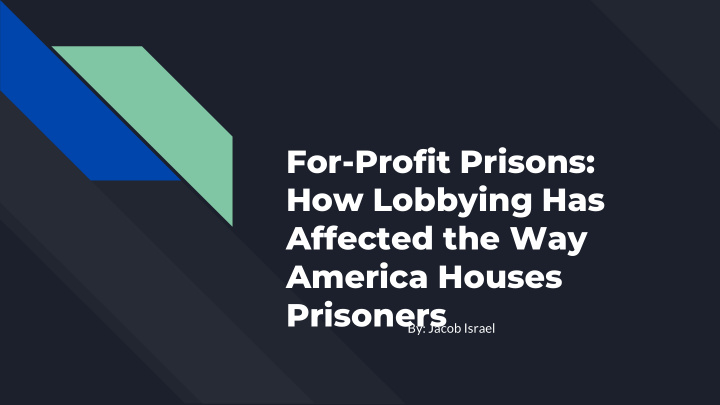



For-Profit Prisons: How Lobbying Has Affected the Way America Houses Prisoners By: Jacob Israel
Why Private Prisons? I chose to focus my research on private prisons because I believe the privatizations of corrections a major component of American criminal justice that needs more attention in the public debate.
Process 1. My initial research focused whether or not private prisons had higher or lower recidivism rates than public prisons. 2. Every peer-reviewed study on this subject published in the last ten years that my research uncovered concluded that for-profit prisons had higher recidivism rates. 3. Since my research answered my initial question, I redirected my research toward determining why private prisons are so widespread. 4. I refocused my research on the question of whether lobbying and campaign contributions might affect the decision by state governments on opening or keeping open private prisons.
Literature Reviewed Gilbert, G. Mobley, A. Shichor, D. (1999). Private Prisons, Criminological Research, and ● Conflict of Interest: A Case Study. Crime and Delinquency. This journal article addressed the conflicts of interest in the criminal justice system. The authors cited as one example Charles Thomas, who co-authored the first major study comparing private and public prisons even though he worked for Prison Realty Trust (PRT). PRT later merged with Corrections Corporation of America (CCA).
Literature reviewed Testing Theories of American Politics: Elites, Interest Groups, and Average Citizens ● Martin Gilens-Benjamin Page – Perspectives on Politics – 2014 Gilens and Page research whether or not the will of the people has greater influence than the agenda of economic elites and lobbyists in passing legislation. They found that popular will had a miniscule effect on legislation compared to the influence of the wealthy, whose interests receive far more legislative protection.
Data 1. I collected data on campaign contributions by private prisons from the National Institute on Money in Politics. 2. I collected data on for-profit prison population from the Sentencing Project, an organization that obtained their data from the Bureau of Justice Statistics.
Findings Most states use private prisons to some degree. Did states increase private prison population between 2000 and 2016? ▪ Had 0 in 2000 and had 0 in 2016 ❑ Reduced private prison population ❑ Increased private prison population
Findings The elected officials in ● those states that experienced an increase in the number of inmates housed in private prisons on average receive more campaign donations from private prison corporations than the other states.
Findings Although not every state that has been lobbied experienced an increase in private prison ● population, there is a positive correlation between states increasing their private prison population and the amount of campaign contributions made by private prison companies.
So what? There is a positive correlation between lobbying & campaign donations and increasing populations of private prisons, suggesting that such public policies follow the interests of large campaign donors. It would seem the evidence establishes a need for greater transparency and public awareness about the influence of lobbying and campaign donations made by private prison corporations. Although my research did not identify specific elected officials who pushed for, or approved, private prisons in their state, there is a strong possibility they were lobbied.
Thank you. Questions? ●
Recommend
More recommend